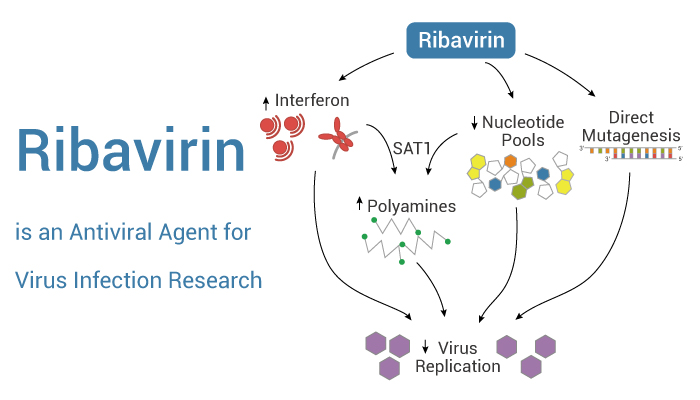Ribavirin is the first nucleoside analogue that exhibits broad-spectrum antiviral activity. Meanwhile, Ribavirin is an IMP dehydrogenase inhibitor. Noticeably, Ribavirin has broad spectrum antiviral activity against various viruses, including DNA and RNA viruses. For example, Ribavirin is active against HCV, HIV, RSV, orthopoxvirus and variola virus infection. There are five mechanism of anti-infection action. Generally, indirect mechanisms include reducing cellular GTP pools via IMPDH inhibition, as well as immunomodulatory effects. And the direct mechanisms include inhibition of RNA capping activity, inhibition polymerases, and increases mutation frequency via incorporation of Ribavirin into newly synthesised genomes. Importantly, Ribavirin has been approved for clinical use.

Ribavirin, an orally active Antiviral Agent, can be used for virus infection research.
In vitro, Ribavirin inhibits orthopoxviruses replication with mean IC50 values of 31.3 μg/mL on Vero cells and 8.0 μg/mL on LLC-MK2 cells. Ribavirin shows antiviral activity in Vero cells infected with variola isolates, with a mean IC50 value of 50 μg/mL. Besides, Ribavirin with CM-10-18 enhances the reduction of virus replication. Ribavirin also inhibits DENV (EC50: 3 μM in A549 cells).
In vivo, Ribavirin (40 mg/kg, p.o., once a day) improves the antiviral efficacy of CM-10-18 (75mg/kg) in DENV infected mice. Ribavirin (100 mg/kg, i.p., daily for 9 days, starting 2 h after infection) shows anti-Enterovirus 71 efficacy in ICR mice. More precisely, Ribavirin increases survival rate, and reduces the viral loads in the brains, brain stems and spinal cords.
Thus, Ribavirin is an orally active antiviral agent and an IMP dehydrogenase inhibitor. Ribavirin potently inhibits kinds of virus in cells and in animal models.
Reference:
[1] Graci JD, et al. Rev Med Virol. 2006 Jan-Feb;16(1):37-48.
[2] Baker RO, et al. Antiviral Res. 2003 Jan;57(1-2):13-23.
[3] Chang J, et al. Antiviral Res. 2011 Jan;89(1):26-34.